
Today, let’s explore the galaxy that includes our very own planet Earth. Additionally, we’ll discuss the vastness of cosmic distances and the entirety of the universe.
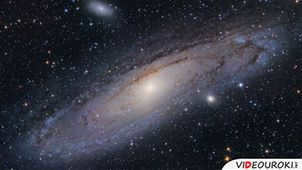
Currently, it is not possible to view or distribute the video lesson to students
In order to access this lesson and the rest of the video lessons included in the package, you will need to add it to your personal account.
Unlock amazing possibilities


Lesson plan for “Our Galaxy. The Spatial Scale of the Observable Universe.”
“The stillness of these spaces horrifies me.”
After exploring the physical properties of stars, we will now discuss star clusters and galaxies, while also providing an understanding of the immense distances that separate our galaxy from others.
Our galaxy is known as the Milky Way. It received this name from ancient Greek myths, where it was believed that the Milky Way is the spilled milk from the infant Hercules while being nursed by the goddess Hera. The Milky Way truly resembles spilled milk, as it is a wide luminous band in the sky.
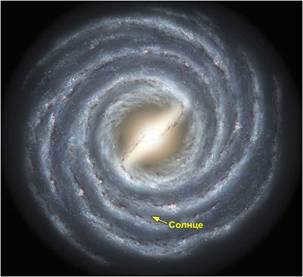
The universe is home to an incredible number of galaxies. Despite this vastness, we can categorize them into three main groups: elliptical, spiral, and irregular galaxies. Elliptical galaxies are shaped like circles or ellipses. Spiral galaxies, on the other hand, consist of a nucleus and multiple spiral arms or branches. Irregular galaxies lack a defined nucleus and rotational symmetry.

Let’s examine these various kinds of galaxies in greater detail. Elliptical galaxies are unique in that they lack any internal organization and possess minimal amounts of gas and dust. Observations indicate that these galaxies do not exhibit rotation and their luminosity diminishes from the core to the outer regions. The masses of the most massive elliptical galaxies are estimated to be around 10^43 kilograms, which is equivalent to approximately ten trillion times the mass of the Sun.
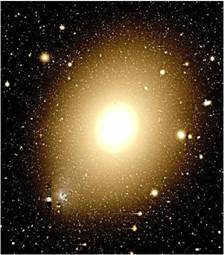
Unlike elliptical galaxies, spiral galaxies are characterized by rotation and contain a significant amount of gas and dust. These particles are concentrated in formations known as galaxy arms, which extend outward from the nucleus. The high concentration of gas and dust clouds, as well as the presence of blue stars, suggests that active star formation is occurring within the arms of these galaxies.
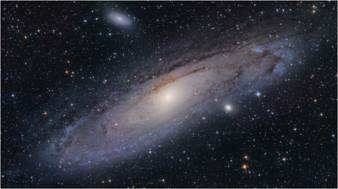
Based on modern understanding, spiral galaxies typically have a mass ranging from ten billion to a trillion times that of the sun. It’s important to note that the arms of these galaxies don’t always directly originate from the nucleus. In certain galaxies, there is a transverse band, known as a lintel, that intersects the nucleus. The arms then branch off from the ends of this lintel. One of the star systems nearest to us is the Andromeda Nebula, which happens to be a spiral galaxy without a central junction. Researchers tend to hypothesize that our own galaxy is similar in structure to the Andromeda Nebula.
Not much is currently known about irregular galaxies. They are galaxies that lack structure and do not conform to typical astronomical models used to describe elliptical and spiral galaxies. There is a hypothesis suggesting that irregular galaxies may have been spiral or elliptical in the past, but were subsequently distorted due to gravitational forces.
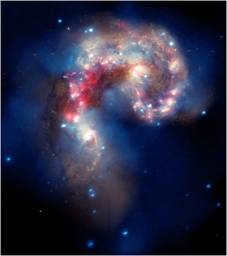
There exist various other categories of galaxies that must not be overlooked. It has been discovered that certain galaxies have intense activities occurring in their nuclei, resulting in the expulsion of immense amounts of matter (approximately a hundred thousand times the mass of the Sun) at incredibly high velocities (around three thousand kilometers per second). These specific galaxies are commonly referred to as active galaxies. A subset of active galaxies are known to emit strong levels of radio waves, and are thus classified as radio galaxies.

However, there are even more powerful sources of radio emission known as quasars – quasi-stellar radio sources. Quasars have a luminosity that is hundreds of times greater than that of regular galaxies. For instance, the nearest quasar to us possesses a maximum luminosity exceeding that of the Sun by a trillion times. According to current theories, supermassive black holes with a mass billions of times greater than that of the Sun exist at the core of quasars. A star can easily be devoured by a quasar by simply absorbing the star’s gas until nothing remains. Due to the limitations of current technology, the study of quasars is still incomplete, leaving the question of their organization unanswered.
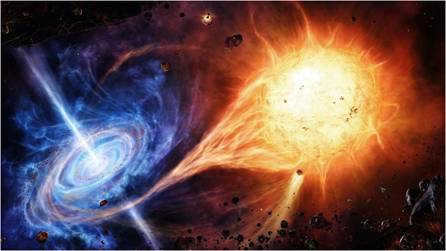
If we consider it, we will observe this fact: numerous galaxies are located thousands or even millions of light years away from us. As a result, we are able to observe the past and thus attempt to observe the “early Universe.”
Let’s explore an intriguing detail – galaxy dispersion. The main idea here is as follows: to analyze the physical characteristics of galaxies, we employ the method of spectral examination. Extensive observations have revealed the following: the lines in the spectra of all recognized galaxies are shifted towards the red section of the spectrum. towards the red section of the spectrum. This phenomenon is referred to as redshift.


It was further noted that the proportion of the displacement to the wavelength of the spectral line detected in the lab remained consistent across all lines in the spectrum for a specific galaxy. This indicated that galaxies are undergoing a motion away from our point of observation. The explanation for this occurrence is connected to the Doppler effect – a modification in the frequency and wavelength of waves perceived by a receiver triggered by the movement of a source.
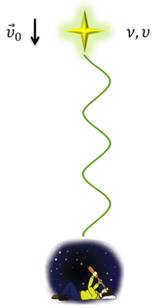
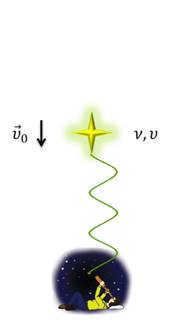
Let’s examine the Doppler effect using a specific example. Consider a light source emitting electromagnetic waves with a constant frequency ν and a wave propagation speed . Remember that the wavelength of a wave is determined by the ratio of the wave’s propagation speed to its frequency. Now, let’s conduct an experiment: we’ll move this source towards the observer with a velocity . As a result, the observer will perceive a shorter wavelength than the actual wavelength (known as the blueshift).
Similarly, if we move the source away from the observer with a velocity , the observer will perceive a longer wavelength than the actual wavelength (known as the redshift).
After recording the redshift of all observed galaxies, astronomers reached the conclusion that these galaxies are in motion away from the Milky Way. The determination of the distances from us to other galaxies has been made possible by the redshift. Following the determination of these distances, Edwin Hubble uncovered an intriguing relationship: it became apparent that the speed at which galaxies move away increases in a direct proportion to their distance. This relationship came to be known as Hubble’s law. The formula that describes Hubble’s law includes a coefficient of proportionality, referred to as the Hubble constant. The numerical value of this constant can vary depending on the units of measurement. In our case, it should be used with the velocity measured in km/s and the distance measured in Mpc.
The scattering of galaxies can be explained by the fact that the Universe is expanding. The concept of a non-stationary Universe was first proposed by Alexander Friedman, who also analyzed it within the framework of the general theory of relativity. Friedman’s work demonstrated that a Universe filled with matter cannot remain stationary, but instead must either expand or contract. This conclusion is supported by the observed pattern of galaxy expansion. Thus, it can be concluded that the Universe is constantly expanding.
Undoubtedly, numerous inquiries emerge: where exactly is it extending to? What lies in those areas where the Universe’s expansion has yet to reach? The responses to these inquiries are likely beyond the scope of human understanding. Let us only provide approximations for the radius and age of the observable Universe. Calculating the Universe’s radius can be achieved through Hubble’s law, utilizing the expansion rate as the utmost conceivable velocity – the speed of light.

Hence, the furthest distance at which any celestial bodies or astronomical objects are detectable is four gigaparsecs.

In addition to Hubble’s law, we can also use it to determine the age of the universe. Let’s take a galaxy located r units away from our own galaxy as an example. By measuring the speed at which this galaxy is moving away from us, we can calculate the amount of time that has passed since the expansion started. There is a straightforward formula that can be used for this purpose.

– The primary categories of galaxies are – elliptical galaxies, spiral galaxies, and irregular galaxies.
– A galaxy – is a system held together by gravity that consists of stars, star clusters, and interstellar gas and dust. All objects within a galaxy orbit around a common center of mass.
– Our galaxy is known as the Milky Way and it is a spiral galaxy without a central bar. It has a diameter of approximately 30 kpc. One of the closest galaxies to the Milky Way is the Andromeda Galaxy.
– The Doppler effect – is the alteration in the frequency and wavelength of waves detected by a receiver due to the motion of a source.
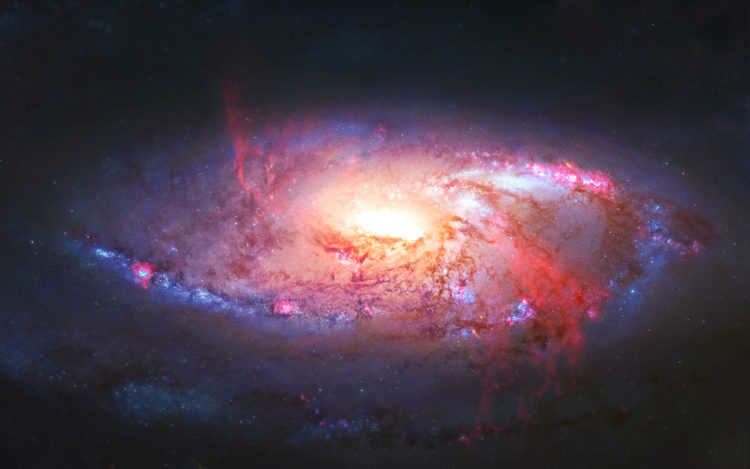
- Galaxies
The term “galactics” (Dr.-Greek γαλαξίας) is derived from the Greek word for our Galaxy (κύκλος γαλαξίας), which means “milky ring” and describes the phenomenon observed in the night sky. Initially, astronomers referred to various celestial objects believed to be spiral nebulae as “island universes” or “star islands” because they hypothesized that these objects were massive clusters of stars. However, as it became evident that these objects were similar to our own Galaxy, the terms “island universes” and “star islands” fell out of use and were replaced by the term “galaxy”.
Galaxies are massive celestial systems where stars are held together by the force of gravity. According to the concept of a constantly expanding universe, researchers have established that galaxies first formed from nebulae composed of gas and dust around 10 billion years ago. Some galaxies are home to trillions of stars … According to the concept of a constantly expanding universe, researchers have established that galaxies first formed from nebulae made up of gas and dust approximately 10 billion years ago. Some galaxies contain trillions of stars. The smallest galaxies have around a million times fewer stars and resemble globular clusters found in the Milky Way, although they are much larger in size. Alongside regular stars, galaxies also contain interstellar gas, dust, and a variety of “exotic” objects such as white dwarfs, neutron stars, and black holes.
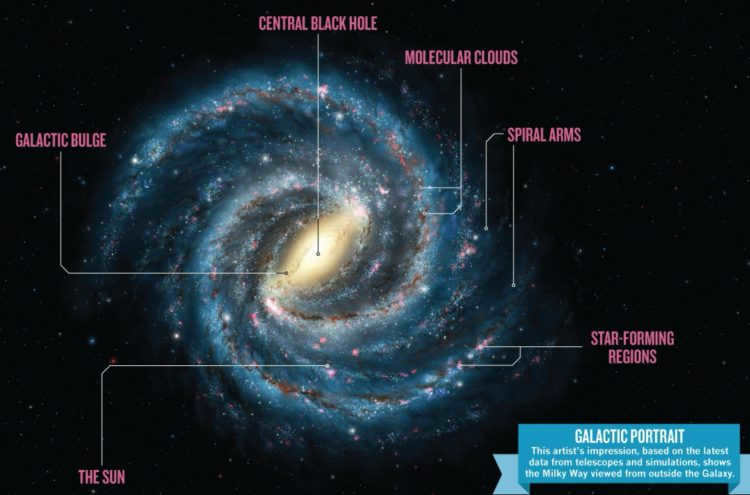
In the cores of numerous luminous galaxies, there exists a denser region referred to as the nucleus, and within the nuclei of certain galaxies, there are even smaller cores. The characteristics of these cores vary significantly from the other regions of the galaxies. They exhibit active processes that involve the emission of energy. There are galaxies that are known to have remarkably active processes occurring within their nuclei.
Gas within galaxies is not only dispersed among stars, but also gives rise to massive clouds (with masses of up to millions of solar masses), luminous nebulae surrounding hot stars, and dense, cold gas-dust nebulae. Stellar systems can have masses reaching hundreds of billions of solar masses. Even the smallest dwarf galaxies have masses that are only about 100 thousand times greater than that of the Sun. As a result, the mass range of galaxies is much broader than that of stars, with the heaviest and lightest stars differing in mass by a factor of less than 1000.
The appearance and structure of stellar systems exhibit significant variation, leading to the classification of galaxies into different morphological types.
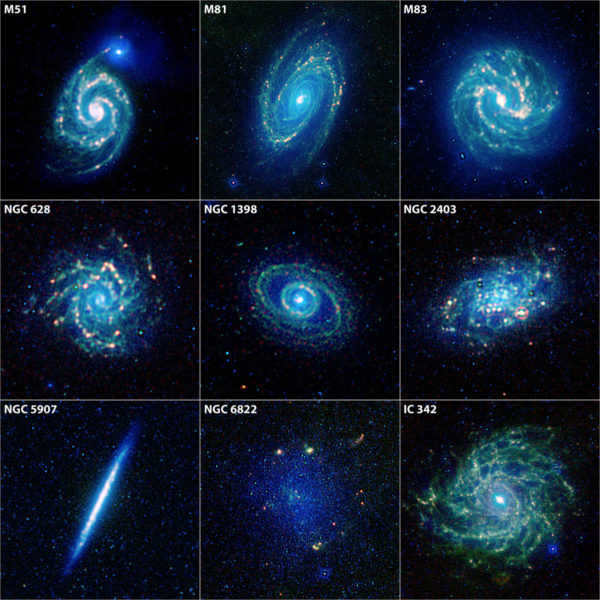
There are four primary classifications of galaxies:
- Elliptical galaxies(E) are galaxies that lack a disk component or have a weakly contrasted one. All other galaxies are disk galaxies.
- Spiral galaxies(S) – galaxies that possess spiral arms. Occasionally, the arms may evolve into rings.
- Lenticular galaxies(S0) – galaxies that have a similar structure to spiral galaxies, except for the absence of a distinct spiral pattern. This is due to the low presence of interstellar gas and, therefore, a low rate of star formation.
When it comes to classifying galaxies, the Hubble classification by subspecies is often quite useful. The Hubble division, which encompasses all galaxies, is based on their visual structure. While it accurately describes elliptical galaxies, it can lead to different classifications for the same spiral galaxy. In 2003, Michael Drinkwater from the University of Queensland identified a new type of galaxy known as ultracompact dwarf galaxies.
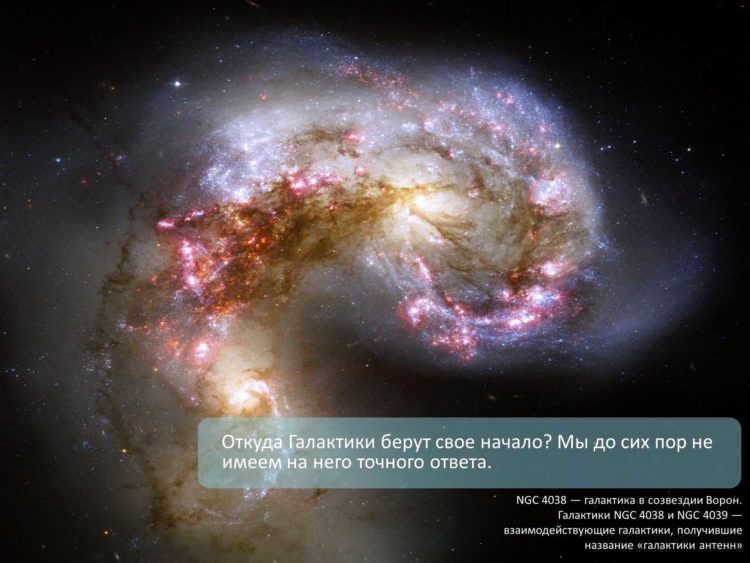
Galaxies: Their Origin and Evolution
The Hierarchical Theory
According to the initial concept, the formation of galaxies began with the emergence of the first stars in the Universe, which then gravitationally merged into clusters and eventually formed galaxies. However, recent advancements in telescope technology have allowed scientists to observe objects that existed around 400 million years after the Big Bang, casting doubt on this theory.
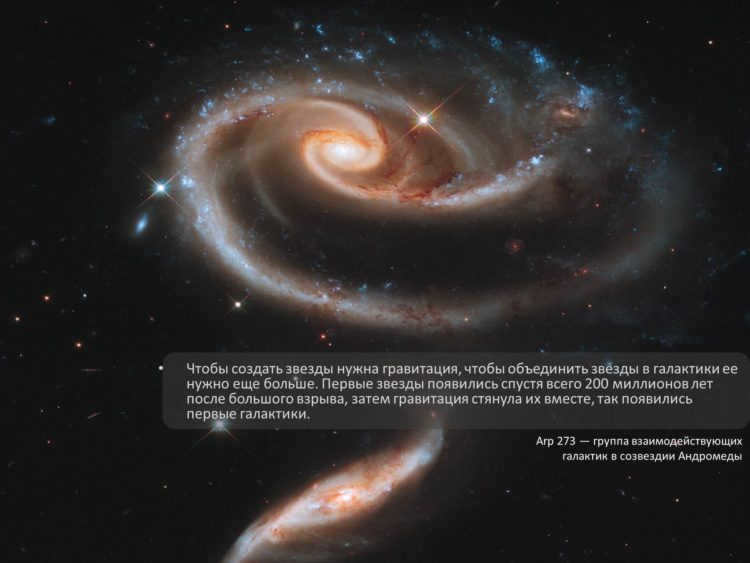
It has been discovered that during that particular era, galaxies were already in existence. It is believed that there was insufficient time between the emergence of the initial stars and the aforementioned phase of the Universe’s evolution for galaxies to have formed.
Inflationary theory
There is another widely accepted version of the inflationary theory. It is known that the vacuum is constantly experiencing quantum fluctuations. These fluctuations occurred during the early stages of the Universe when it underwent a process of inflationary expansion, expanding at a speed faster than the speed of light. This means that the quantum fluctuations themselves were also expanding, reaching sizes that were approximately 10^12 times larger than their initial size. Some of these fluctuations, which existed at the end of the inflationary period, remained “inflated” and became the first gravitational inhomogeneities in the Universe. Over the course of approximately 400 million years, matter gravitationally compressed around these inhomogeneities, leading to the formation of gas nebulae. This eventually initiated the process of star formation and the transformation of nebulae into galaxies.
One of the most enigmatic areas in the cosmos lies within its central region. Its physical characteristics differ so greatly from the surrounding areas of space that it took scientists an extensive period of time to comprehend the nature of this phenomenon.
Only recently, it has been precisely determined that the central segment of our galaxy is inhabited by a black hole – a region of space with altered properties.
The age of our galaxy is relatively young – approximately 12 billion years, and the processes of stellar formation in its core continue to be actively ongoing. Numerous white dwarfs – youthful stars, massive clusters of luminous gas, black holes of varying strengths, and neutron stars have all been discovered within.
All of these elements combine to create an immense, inconceivably vast cosmic “kitchen” that continues to supply the Universe with new stars at an astonishing rate.
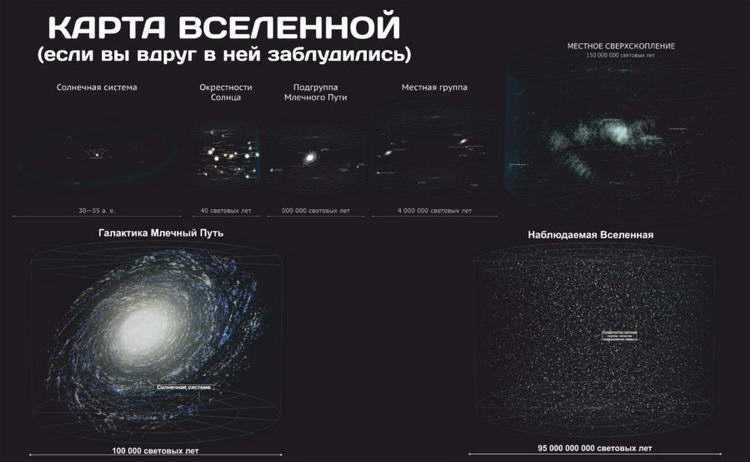
Is the universe or the galaxy bigger?
It is important to note that our galaxy is not the only one in the Universe, despite its size. Astronomers have now identified over a hundred other galaxies.
Some of these galaxies are relatively close to ours and can even be seen with the naked eye, like the galaxy in the constellation of Veronica’s Hair. Others can only be observed through powerful telescopes at observatories. There are also galaxies that can only be distinguished from a space station, where the atmosphere does not interfere with space observation.
Scientists have postulated that the Universe is boundless, containing an infinite number of galaxies within it. These galaxies vary in their origins, with some emerging from luminous clouds of gas and dust, while others resemble our own Milky Way, and still others are in a state of decline, having depleted their energy reserves. Despite extensive research, no definitive theory has yet been established to account for the genesis of the Universe and the formation of stars and galaxies within it. It is possible that in the distant future, humanity will acquire this knowledge, but for now, we can only engage in the most imaginative conjectures.
The Galaxy of the Milky Way
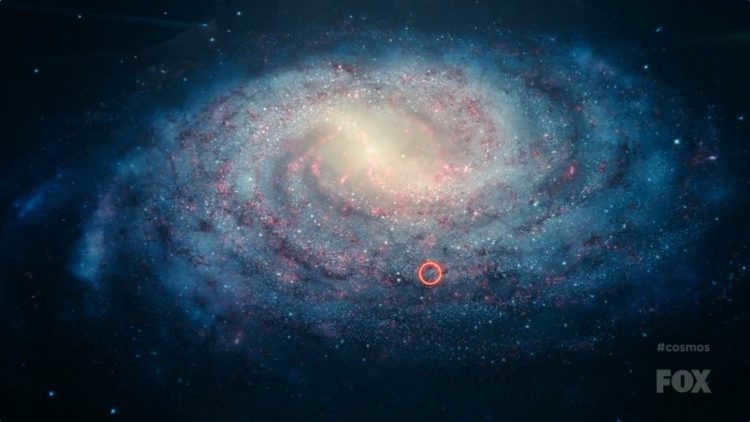
Discovery and Appellation
Our galaxy possesses an intriguing designation, as its nebulous appearance resembles a gossamer streak. The appellation has ancient origins and is derived from the Latin term “Via Lactea”. This designation first emerges in the opus “Tadhira” by Nasir al-Din Tusi. He scribes: “Depicted by a myriad of diminutive and closely clustered celestial bodies. They are situated in proximity, thus appearing as specks. The hue bears resemblance to that of milk…”.
Researchers conjectured that the Milky Way was brimming with stars, yet this remained purely speculative until 1610. It was during this period that Galileo Galilei directs the inaugural telescope towards the heavens and discerns individual stars. This revelation also discloses a novel verity to humankind: there exist a multitude of stars exceeding our previous estimations, and they are an integral component of the Milky Way.
The situation underwent a transformation during the 1920s. Edwin Hubble successfully persuaded people that what we were observing were not spiral nebulae, but rather individual galaxies. It was at that moment that we were able to comprehend the structure of our own galaxy. From that point onwards, it became evident that our galaxy was a spiral galaxy with a hub.
Location
The Milky Way can be easily identified by its wide and elongated white line that resembles a milky pathway. Interestingly, this star cluster has been visible since the formation of planets. In fact, this region acts as the central point of the galaxy.
The galaxy stretches across a distance of 100,000 light-years. If you were to observe it from above, you would notice a bulge in the center from which four large spiral arms emerge. This particular type of galaxy represents two-thirds of all galaxies in the universe.
Unlike the well-known spiral shape, the specimens of jumpers have a central rod and two arms that branch out. Our galaxy has two primary arms and two secondary arms. Our solar system is located in the Orion arm. The Milky Way is not stationary but instead rotates, carrying all celestial objects along with it. Our solar system is moving at a speed of 828,000 kilometers per hour. However, the galaxy is incredibly vast, so it takes 230 million years to complete one orbit.
A significant amount of dust and gas accumulates within the spiral arms, providing ideal conditions for the formation of new stars. These arms extend from a galactic disk that spans about 1000 light-years. In the center, there is a bulge filled with dust, stars, and gas. As a result, only a small fraction of the total number of stars in the galaxy can be observed. This is due to the obstructed view caused by the dense gas and dust haze.
Located at the center of the galaxy is an immensely massive black hole, which is billions of times the mass of the Sun. It is believed that this black hole was much smaller in size initially, but due to its regular consumption of dust and gas, it has been able to grow in size. It possesses an insatiable appetite, as it has been known to devour even entire stars. Although it cannot be directly observed, its presence is detected through its gravitational influence.
Surrounding the galaxy is a halo comprised of hot gas, which serves as the home to aging stars and globular clusters. This halo extends for hundreds of thousands of light-years, yet it only contains a mere 2% of the total number of stars found within the galactic disk. Additionally, we mustn’t overlook the significant presence of dark matter, as it accounts for a staggering 90% of the galaxy’s mass.
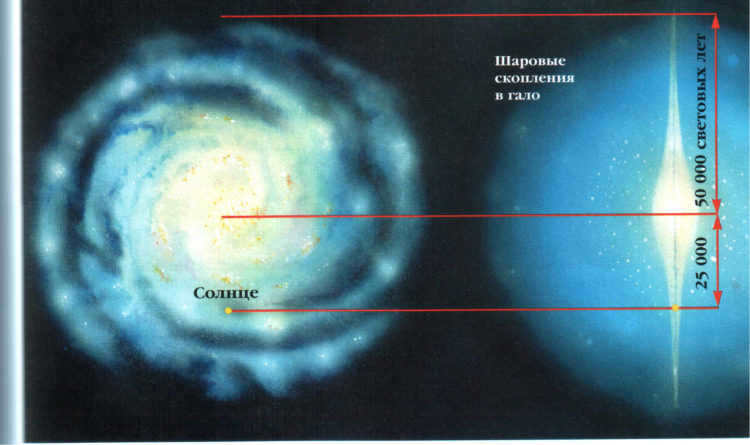
Galaxy Structure and Composition
Upon observation, it becomes apparent that the Milky Way galaxy divides the celestial expanse into two nearly identical hemispheres. This indicates that our system is situated in close proximity to the galactic plane. It is worth noting that the galaxy possesses a relatively low surface brightness due to the concentration of gas and dust within its disk. This not only obstructs our view of the galactic center, but also obscures whatever may be concealed on the opposite side.
If one were to venture beyond the confines of the Milky Way and gain an aerial perspective, they would behold a spiral galaxy adorned with a prominent bar. This majestic formation spans a staggering distance of 120,000 light-years and has a width of 1,000 light-years. For a considerable period, scientists mistakenly believed that there were four spiral arms, but in actuality, there are only two: Shield-Centauri and Sagittarius.
The arms of the galaxy are formed by swirling waves of dense matter. These waves move throughout the galaxy, compressing dust and gas and sparking the formation of new stars. This process occurs in all galaxies of this particular type.
If you have come across images of the Milky Way, they are artistic representations or depictions of similar galaxies. It is challenging for us to fully grasp the appearance of our own galaxy since we are situated inside of it. It’s like trying to describe the exterior of a house without ever stepping outside its walls. However, we can always look out the window and observe the neighboring structures.
Through ground and space missions, scientists have determined that the galaxy contains between 100 and 400 billion stars. Each of these stars could potentially have its own planetary system, meaning there could be hundreds of billions of planets in total. Additionally, approximately 17 billion of these planets are similar in size and composition to Earth.
About 90% of the mass is attributed to dark matter. The nature of this mysterious substance has yet to be fully understood, but its existence is evident through the rapid rotation of galaxies and other observable effects. Dark matter plays a vital role in preventing galaxies from collapsing under their own gravitational forces.
What lies ahead for the Milky Way?
The Milky Way is thought to have formed through the merging of smaller galaxies. This process is ongoing, as the Andromeda galaxy is currently heading towards us, and in about 3-4 billion years, it will collide with the Milky Way, resulting in the formation of a massive elliptical galaxy.
Both the Milky Way and Andromeda are not isolated entities but are part of a larger structure known as the Local Group, which itself is a component of the Virgo Supergroup. This vast region, spanning 110 million light years, is home to numerous galaxy clusters and groups.
If you haven’t had the opportunity to marvel at the splendor of your own galaxy, I urge you to do so without delay. Seek out a serene and obscure outdoor setting, where you can bask in the magnificence of this awe-inspiring assemblage of celestial bodies.
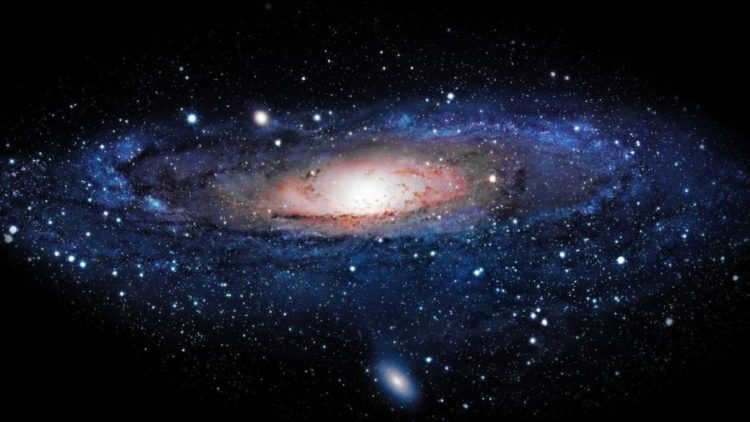
Recent Study
Scientists in the United States have conducted a new study to determine the estimated quantity of compact black holes in the Milky Way. The researchers focused on black holes with masses ranging from a few solar masses to a few hundred solar masses. Surprisingly, their calculations revealed that there may be approximately one hundred million of these small black holes in our galaxy. This finding exceeded the expectations of the scientists and suggests that the nearest black hole could be relatively nearby our solar system. The study has been published in the reputable scientific journal, Monthly Notices of the Royal Astronomical Society.
The scientists conducted a study based on astronomical data about the distribution of visible stars according to their mass. By calculating the proportion of stars that are more massive than the Sun and are likely to collapse into black holes at the end of their lifespan, the researchers discovered that the occurrence of such events is more common than initially believed. It was determined that there are approximately 100 million stellar-mass black holes in our Milky Way galaxy, where our solar system is located. The study did not cover black holes of intermediate masses or supermassive black holes.
Scientists also observe that in our Galaxy, the most common weight of a black hole formed from a star is relatively small, typically less than 30 times the mass of our Sun. In the small companion galaxies that orbit our own, the average weight of these black holes is closer to one hundred times the mass of our Sun. This difference can be attributed to the lower abundance of heavy elements in the dwarf galaxies. With fewer heavy elements, there is less stellar wind (charged particles expelled by a star) emitted from these stars. As a result, the massive stars in dwarf galaxies retain more of their mass throughout their lifespan, ultimately leading to the formation of larger black holes.
Recorded Content
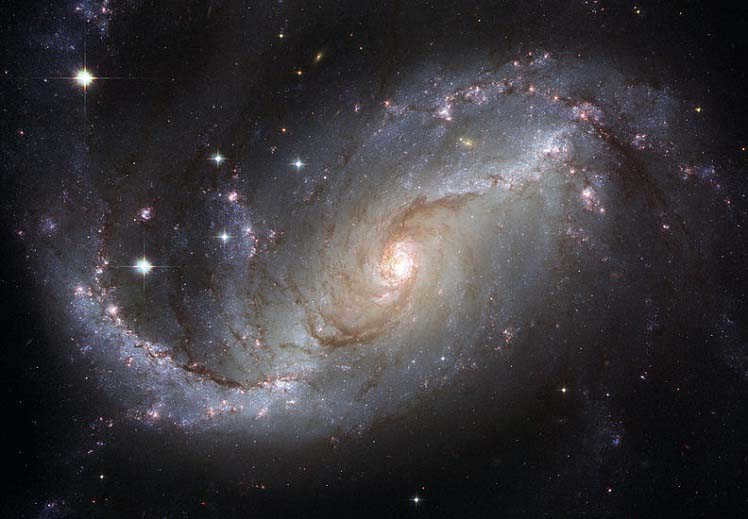
A galaxy refers to a complex arrangement of stars, star clusters, dust, gas, dark matter, and various celestial bodies like asteroids and planets. In the past, they were commonly referred to as “star islands.” In a galaxy, all these entities are interconnected through gravitational energy, resulting in a revolving motion around a central mass.
The Universe contains a vast number of galaxies, estimated to be around 100 billion, and their distribution is not uniform. There are regions in space that lack stars and systems, known as woads. On the other hand, galaxies can also come together to form groups.
Calculating the Distance in the Vastness of Space
There are two methods to determine the distance between galaxies. The first approach is used for relatively short distances, such as those to the nearest star system or a few star systems. These distances are measured in megaparsecs (1 parsec = 1pc = 3.26 light-years).
Furthermore, a light-year represents the distance that light travels within the span of 365.25 days. The distance between two galaxies is so immense that comprehending it becomes challenging. For instance, if we consider the average speed of 17 km/s (which is the typical speed of the unmanned interstellar spacecraft Voyager 1), it would take approximately 440 million years to travel from our planet to the closest object of this kind (a dwarf galaxy in the Canis Major constellation). This distance is even considered relatively close.
However, the redshift z is employed to denote significant separations between galaxies. Expressed in terms of redshift z (the decrease in radiation frequencies caused by the distance between other galaxies and our own galaxy), this means that galaxies situated at varying distances from Earth emit radiation at different frequencies.
Galactic Properties
Galaxies exhibit a wide range of sizes and shapes. They can range from dwarf galaxies to massive ones. Some may have a spiral structure, similar to our own Milky Way, while others may be spherical, disk-shaped, lenticular, or have irregular shapes that are difficult to comprehend.
Their mass can vary from 10^7 solar masses to 10^12, and their size can range from 16 to 800 light years. The rotation speed, which can be between 50 and 300 km/s, is also a significant characteristic.
Interestingly, the Milky Way falls somewhere in the middle in terms of these characteristics. It is not the largest, brightest, fastest rotating, or has the longest period of revolution around the center.
Fascinating facts about galaxies
Galaxies have the ability to interact with one another. For instance, if the distance between them is relatively small (not more than their diameter), one galaxy can have a significant impact on the other based on its size and mass. It can even attract all of the dark energy and intergalactic gas from its neighboring galaxy, causing the smaller galaxy to become inferior.
These interactions sometimes result in galaxy mergers, which is a remarkably beautiful process that takes a considerable amount of time. Initially, the galaxies gradually approach each other, spiraling around one another. Eventually, the stellar systems and components merge, accompanied by bursts of star formation that illuminate the merging galaxies.
The stellar archipelagos consist of countless, numerous stars, which are frequently organized into ordered arrangements, like our own solar system. In turn, the latter encompasses countless planets. All of this is structured into systems that adhere to specific laws.
Furthermore, let’s not overlook the additional celestial entities that bring a touch of vibrancy and unpredictability to these systems: hazardous and less hazardous asteroids, magnificent comets, and others.
The Solar System
There are 8 primary planets with their respective satellites, along with numerous asteroids, comets, and other celestial objects that orbit around the Sun. All of this constitutes an immense and intricate system.
Stars
Spherical celestial bodies that emit vast quantities of light are referred to as stars. They come in various types, which are determined by the brightness, size, mass, and other characteristics of the stars.
© Naturae.ru, 2015-2023
Copying of materials of the site is allowed only with the indication of an active link to the source.
The Organization of a Galaxy: Nucleus, Balge, Halo, Stellar Disk.
Spiral galaxies, such as our Milky Way, possess a similar internal structure.
A typical spiral galaxy is composed of three primary components:
The central region of the galaxy is known as the nucleus, surrounded by the halo, which is in turn enveloped by a collection of stars known as the stellar disk.
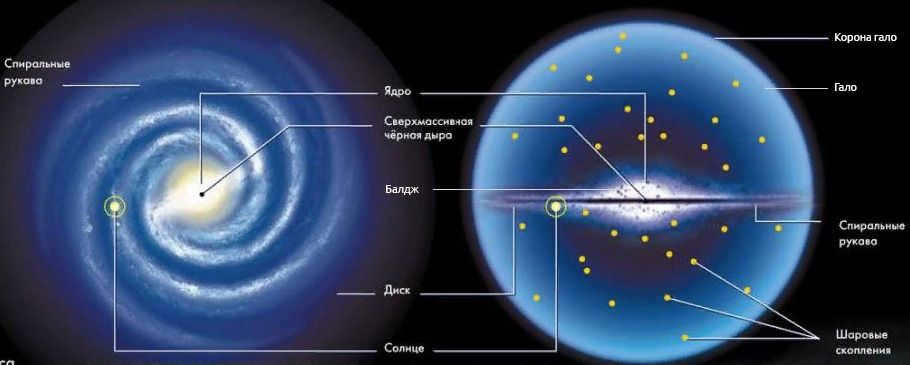
The Milky Way spiral galaxy is composed of various elements and regions, which can be observed from both side and top views.
Central region of the galaxy
The central region of the galaxy is relatively small compared to the overall size of the galaxy. However, it plays a crucial role as it contains the gravitational center of the entire galaxy. This center is typically occupied by a supermassive black hole with an enormous mass (for the Milky Way, the estimated mass of this black hole is equivalent to about three million times the mass of our Sun!).
Galactic halo
The Galactic halo refers to a massive spherical cloud of stars centered around the galactic nucleus. It is this halo that sets the boundaries of our Galaxy. The halo’s radius is significantly larger than the size of the galaxy’s stellar disk, and some estimates suggest it extends to several hundred thousand light years.
Comprised mostly of ancient, faint, and low-mass stars, the halo contains individual stars as well as globular clusters that can contain over a million stars. The spherical component of the Galaxy is estimated to be over 12 billion years old, which is generally considered to be the age of the Galaxy itself.
Halo stars are characterized by their extremely low abundance of heavy chemical elements. Stars that form in globular clusters have hundreds of times fewer metals than the Sun.
The stars in the spherical component are concentrated towards the center of the Galaxy. The central, densest part of the halo, located within a few thousand light-years of the galaxy’s center, is known as the bulge.
The stars and star clusters in the halo have highly elongated orbits around the center of the Galaxy. Due to the almost random rotation of individual stars (meaning neighboring stars can have very different velocities), the halo as a whole rotates at a very slow pace.
Bulge
The densest and closest part to the core of the halo is referred to as the bulge. If we were to reside on a planet situated near a star within the bulge of the Galaxy, we would observe not the typical “star dots” but rather dozens of stars in the sky, shining as brightly as our Moon.
However, the Sun is positioned at a considerable distance from the core of the Galaxy, approximately 26,000 light years away. As a result, while in the vicinity of the Sun within the disk, there is an average of one star per 8 cubic parsecs. In contrast, in the center of the Galaxy, there are approximately 10,000 stars within each cubic parsec. The center of the Galaxy lies in the direction of the Sagittarius constellation.
The stellar disk (to be more precise, the stellar disk and the gas-dust disk) is the largest and most massive region of the galaxy, spanning hundreds and thousands of light-years from the center. The estimated mass of the stellar disk in the Milky Way is approximately 150 billion solar masses. In contrast to the spherical shape of the central part of the galaxy, the stellar disk resembles two saucers stacked together – flat in cross-section and gradually thinning from the center to the outer regions.
The composition of the stellar disk differs greatly from that of the halo. The disk is populated by young stars and star clusters, which are no more than a few billion years old. These components are known as the flat component and they contain numerous bright and hot stars.
The gas in the disk of our Galaxy is primarily concentrated close to its plane. It is not evenly spread out, but instead forms many gas clouds – ranging from massive superclouds that have an irregular structure and span thousands of light-years, to smaller clouds that are no larger than a parsec.
Hydrogen is the main chemical element in our Galaxy, with helium making up about 1/4 of it. In comparison to these two elements, the others are found in very small quantities. On average, the chemical composition of stars and gas in the disk is nearly identical to that of the Sun.
Spiral arms
One of the most prominent features in the stellar disks of galaxies such as ours are the spiral branches (or arms). These arms are responsible for giving this particular type of object its name – spiral galaxies. The spiral structure within our own galaxy is highly developed. The arms are primarily populated by young stars, numerous scattered star clusters and associations, and chains of dense interstellar gas clouds where star formation actively takes place.
Spiral branches are home to a multitude of ever-changing and explosive stars, where frequent supernova events occur. Unlike the halo, which rarely shows any signs of stellar activity, the branches are teeming with life as matter continuously moves between interstellar space and stars. The galactic magnetic field, which permeates the entire gas disk, is predominantly concentrated within the spirals.
The spiral arms of the Milky Way are mostly concealed from our view due to absorbing matter. The detailed exploration of these arms began with the introduction of radio telescopes, enabling the study of the Galaxy’s structure through the observation of radio emissions from interstellar hydrogen atoms densely clustered along the Long Spirals.
Based on the current knowledge, the spiral arms are connected to the propagation of compression waves throughout the galaxy’s disk. As these waves pass through the compressed regions, the density of the disk material increases, leading to a higher level of star formation from the gas. The exact reasons behind the formation of these unique wave structures in spiral galaxy disks remain somewhat uncertain. Numerous astrophysicists are actively researching this intriguing phenomenon.
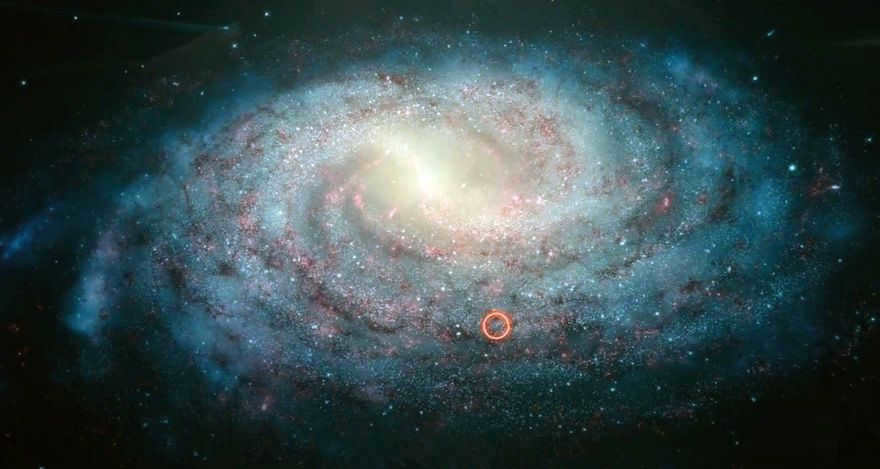
Imagine how our Milky Way galaxy would appear when observed from a vantage point “outside” of it. The approximate position of the Solar System is indicated by the red circle.
The actual size of our galaxy is: 30 kiloparsecs (equivalent to 100,000 light years) in diameter and 1,000 light years in thickness. To put it differently, when seen “sideways,” the galaxy takes on the shape of a lens.
When viewed from above, from its “north pole” situated in the constellation Veronica’s Hair, the galactic disk rotates clockwise on its axis.
Our Galaxy boasts a distinct spiral structure. These spirals are density waves that propagate in the direction of the Galaxy’s rotation, maintaining a constant angular velocity.
Generation of Stars in the Milky Way Galaxy
The formation of the Milky Way Galaxy, along with other spiral galaxies, can be traced back to the gradual rotation of a massive gas cloud that was several times larger than our galaxy.
Originally, this gas cloud consisted of approximately 75% hydrogen and 25% helium, with minimal amounts of heavier elements. Over the course of approximately one billion years, gravitational forces caused this cloud to undergo compression, resulting in fragmentation and the initiation of star formation.
During the early stages, the gas was abundant and located at significant distances from the rotational plane. The initial generation of stars, which included some exceptionally massive ones and globular clusters, were distributed in a manner that mirrored the original gas distribution, forming a near-spherical shape.
The initial population of massive stars rapidly underwent evolution and enriched the surrounding interstellar medium by ejecting heavy elements through supernova explosions. The portion of gas that did not undergo star formation continued to contract towards the center of the Galaxy. As a result of momentum conservation, this gas acquired faster rotation, leading to the formation of a disk where the process of star formation recommenced.
This subsequent generation of stars, known as the second generation, exhibited a higher abundance of heavy elements. The remaining gas further compressed into a thinner layer, giving rise to a flat component that serves as the main site for ongoing star formation. It is important to note that the categorization of two or three generations of stars is somewhat arbitrary, as star formation likely occurred as a continuous process, albeit with potential stages of deceleration.
However, the overall principle remains valid: the galactic disk consists of early spectral class O and B stars, specifically, young stars. Young stars. In contrast, the halo is composed of entities that emerged during the initial phases of the Galaxy’s development, old stars. They have an approximate age of 10 to 12 billion years.
Why can’t we see the brilliantly illuminated center of our galaxy from Earth?
The central regions of the Galaxy emit visible radiation, but it is obscured from our view by dense layers of interstellar matter. These layers, comprised of clouds of dust and gas, are located at a distance of 3-7 kiloparsecs from the center. Fortunately, we are able to observe these regions using infrared technology.
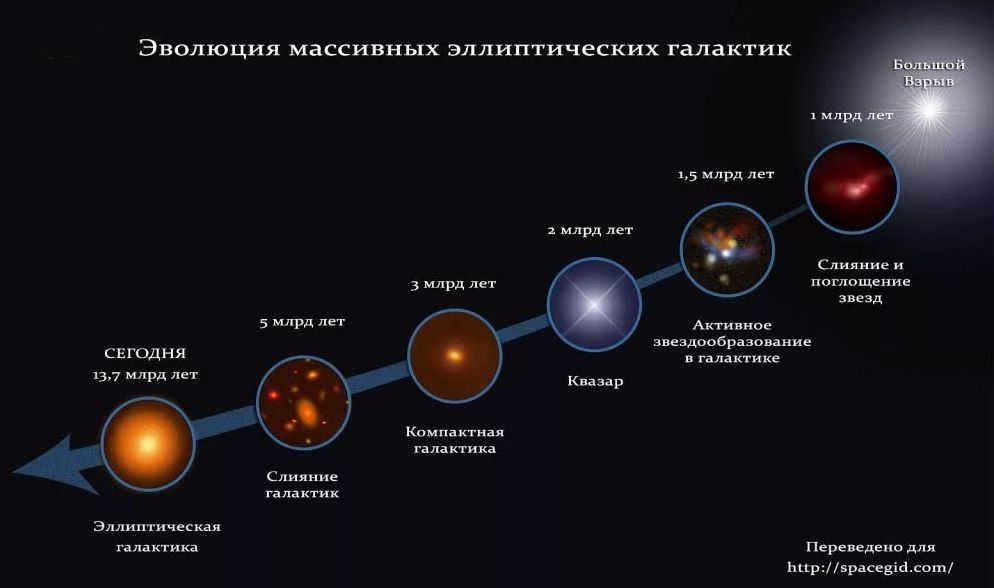
The development of spiral galaxies: from the inception of the universe to the current era
The position of the Solar System within the Milky Way galaxy
Our Sun, situated within the Milky Way galaxy, lies amidst the spiral arms of Sagittarius and Perseus. The Sun, along with the entire solar system, maintains a velocity of approximately 220 km/s, completing a full orbit around the galaxy’s center every 200 million years. Over the course of its 4.5 billion year existence, the Sun has journeyed around the Galaxy roughly 30 times.
The velocity at which the Sun rotates around the center of the Galaxy aligns closely with the velocity at which the spiral arms of the galaxy move in this particular region. The region within the galaxy where the velocities of stars and spiral arms align is referred to as the corotational circle. This region, known as the corotational circle, is considered to be the potential “habitable zone” where life may flourish within the galaxy.
It is worth noting that our Sun is located within this corotational circle.
Astronomy lesson 27. Grade 11. Workbook. Galuso I. V.
Astronomy class 27. 11th grade. Workbook. Galuso I. V.
Lesson 27 on astronomy. Workbook for 11th grade. By Galuso I. V.

Here are the solutions to the inquiries of the twenty-seventh session titled “Our Galaxy” from the Astronomy workbook for eleventh graders. Don’t hesitate to share your inquiries and remarks on the discussion page.
Our Galaxy [ edit edit code ]
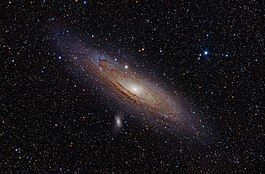
A galaxy is a collection of stars and stellar systems that orbit a shared center of mass. In simple terms, it is a vast assemblage of planetary systems, stars, interstellar gas, meteorites, dwarf planets, and asteroids that have come together due to the force of gravity and move in a circular path around a central point. [1]
Milky Way [ edit edit code ].
The Milky Way is one of the countless galaxies in the vast Universe, encompassing our very own star, the Sun, and the orbiting planets.
Being a spiral galaxy, the Milky Way is also characterized by a central bulge consisting of a colossal stellar system that is held together by the force of gravity. Scientists estimate that the Milky Way has been in existence for over thirteen billion years, during which it has witnessed the birth of approximately 400 billion constellations and stars, along with over a thousand massive gas nebulae, clusters, and clouds. [2]
The densest central region of our galaxy is situated in the constellation of Sagittarius and is referred to as the nucleus of our galaxy.
Star clusters are groups of many stars in the galaxy. There are various kinds of star clusters, including globular and other types.
The organization of our galaxy [ edit edit code ]
Figure 27.1 illustrates the organization of our galaxy (from a “rib” perspective). Take note of the Sun’s location in the galaxy and its primary structural components: nucleus, disk, halo, corona, and central thickening (balge).
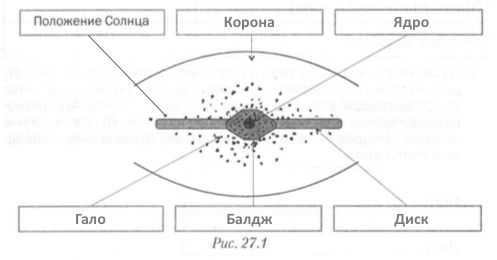
Diagram illustrating the structure of our galaxy [ edit edit code ]
Create a schematic diagram that visually represents the structure of our galaxy as seen from above, and make use of arrows to indicate the locations of the Sun, the nucleus, and the spiral arms.
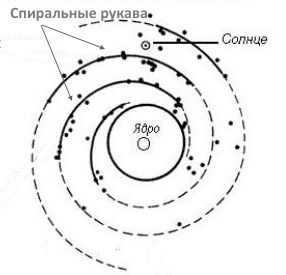
General data on our galaxy [ edit correct code ]
| Size (diameter), kiloparsecs | 3 |
| Distance from the center of the galaxy to the Sun, kiloparsecs | 10 |
| Linear velocity of revolution around the nucleus (at the distance from the Galaxy center to the Sun), kilometers per second | 250 |
| Circulation period (complete revolution of the Sun and stars in its vicinity around the center of the Galaxy), million years | 250 |
| Mass (in solar masses) | 10 12 |
| Age (in billions of years) | 15 |
Arrangement of the galaxy’s halo and disk [ edit edit code ]
Separate the objects belonging to the halo and disk from the given composition of the “population” of the Galaxy:
- red giants;
- long-period Cepheids;
- blue giants;
- short-period cepheids;
- red dwarfs;
- gas-dust clouds;
- globular star clusters;
- scattered star clusters;
Halo – 1, 4, 5, 7. Disk – 2, 3, 6, 8.





